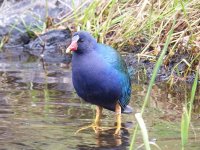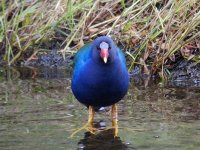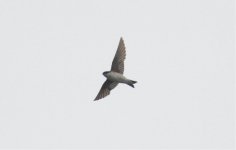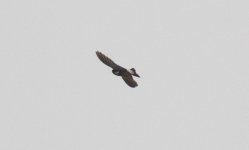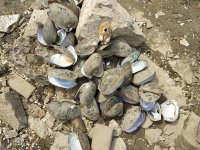Lancy Cheng
Well-known member
I spent a month (May 9th - June 8th) in China for family reunion and did some birding whenever I could. Among the 5 cities I visited, Panjin and Dalian were well planned (big thanks to Owen and Tom! :t . Information of birding in Beijing and Shenyang is more or less available from internet which was helpful. Harbin is the least birded city of all five, so I just winged it. In total, 93 species were observed, 81 in Liaoning province (Panjin, Dalian and Shenyang), 38 in Beijing and 19 in Heilongjiang (Harbin).
. Information of birding in Beijing and Shenyang is more or less available from internet which was helpful. Harbin is the least birded city of all five, so I just winged it. In total, 93 species were observed, 81 in Liaoning province (Panjin, Dalian and Shenyang), 38 in Beijing and 19 in Heilongjiang (Harbin).
Hightlights
While lots of duck species were gone from winter ground, I did manage to see Ruddy and Common Shelducks. I was surprised to learn that Mandarin Duck breeds in Zhaolin Park, Harbin, every year for years. It is a small park, located in the center of business district, with limited water area. The park did a wonderful job by providing breeding boxes.
https://ebird.org/view/checklist/S46114681
I'm happy with 18 shore bird species, most of which were in Panjin/Yingkou wetlands. I'd like to spend days there watching shorebirds. Amazing habitat! Dunlin was abundant while most species showed up in small numbers. Eurasian Oystercatcher was a treat.
I saw two of my 3 target gulls. Black-tailed Gull was everywhere in/near Dalian. The color aberration one at Jinzhou dump was stunning. I am still not fully convinced by the story of Black-tailed Gull at Beijing zoo (https://ebird.org/view/checklist/S46367037). Saunders's Gull was a guarantee in Red Beach but I couldn't find one anywhere else. Black-headed Gull was common and I saw a colony, mostly 2nd calendar year birds, on a small island in Songhua River, Harbin. I was shocked ALL Herring-type gulls were gone. My Newfoundland experience didn't apply there. They are here all year around though winter is still the best gulling season. I'm planning my next trip to China possibly in 2 or 3 years and it will be in winter 8-P
Five tern species was not bad. Little, Whiskered and Gull-billed were lifers. White-winged Tern was not but it's still great to watch them in flocks. I had only seen a single before.
Warbler and raptor: well, I'll be back!
A Purple Gallinule in Newfoundland is the best welcome home gift. It was found just after I left but survived till our June-uary: local temperature is still single digit.
Full list:93
Hightlights
While lots of duck species were gone from winter ground, I did manage to see Ruddy and Common Shelducks. I was surprised to learn that Mandarin Duck breeds in Zhaolin Park, Harbin, every year for years. It is a small park, located in the center of business district, with limited water area. The park did a wonderful job by providing breeding boxes.
https://ebird.org/view/checklist/S46114681
I'm happy with 18 shore bird species, most of which were in Panjin/Yingkou wetlands. I'd like to spend days there watching shorebirds. Amazing habitat! Dunlin was abundant while most species showed up in small numbers. Eurasian Oystercatcher was a treat.
I saw two of my 3 target gulls. Black-tailed Gull was everywhere in/near Dalian. The color aberration one at Jinzhou dump was stunning. I am still not fully convinced by the story of Black-tailed Gull at Beijing zoo (https://ebird.org/view/checklist/S46367037). Saunders's Gull was a guarantee in Red Beach but I couldn't find one anywhere else. Black-headed Gull was common and I saw a colony, mostly 2nd calendar year birds, on a small island in Songhua River, Harbin. I was shocked ALL Herring-type gulls were gone. My Newfoundland experience didn't apply there. They are here all year around though winter is still the best gulling season. I'm planning my next trip to China possibly in 2 or 3 years and it will be in winter 8-P
Five tern species was not bad. Little, Whiskered and Gull-billed were lifers. White-winged Tern was not but it's still great to watch them in flocks. I had only seen a single before.
Warbler and raptor: well, I'll be back!
A Purple Gallinule in Newfoundland is the best welcome home gift. It was found just after I left but survived till our June-uary: local temperature is still single digit.
Full list:93
- Ruddy Shelduck
- Common Shelduck
- Mandarin Duck
- Eastern Spot-billed Duck
- Mallard
- Ring-necked Pheasant
- Little Grebe
- Great Crested Grebe
- Yellow Bittern
- Gray Heron
- Great Egret
- Little Egret
- Chinese Pond-Heron
- Black-crowned Night-Heron
- Oriental Honey-buzzard
- Eurasian Moorhen
- Black-winged Stilt
- Pied Avocet
- Eurasian Oystercatcher
- Black-bellied Plover
- Gray-headed Lapwing
- Lesser Sand-Plover
- Kentish Plover
- Little Ringed Plover
- Whimbrel
- Eurasian Curlew
- Bar-tailed Godwit
- Long-toed Stint
- Red-necked Stint
- Dunlin
- Terek Sandpiper
- Common Sandpiper
- Green Sandpiper
- Common Greenshank
- Saunders's Gull
- Black-headed Gull
- Black-tailed Gull
- Little Tern
- Gull-billed Tern
- White-winged Tern
- Whiskered Tern
- Common Tern
- Rock Pigeon
- Oriental Turtle-Dove
- Spotted Dove
- Indian Cuckoo
- Common Cuckoo
- White-throated Needletail
- Common Swift
- Eurasian Hoopoe
- Common Kingfisher
- Dollarbird
- Gray-capped Woodpecker
- Pygmy Woodpecker
- Great Spotted Woodpecker
- Gray-headed Woodpecker
- Eurasian Kestrel
- Amur Falcon
- Bull-headed Shrike
- Brown Shrike
- Black-naped Oriole
- Azure-winged Magpie
- Red-billed Blue-Magpie
- Eurasian Magpie
- Carrion Crow
- Large-billed Crow
- Barn Swallow
- Red-rumped Swallow
- Willow Tit
- Japanese Tit
- Chinese Penduline-Tit
- Eurasian Nuthatch
- Light-vented Bulbul
- Yellow-browed Warbler
- Arctic Warbler
- Oriental Reed Warbler
- Vinous-throated Parrotbill
- Chestnut-flanked White-eye
- White-browed Laughingthrush
- Korean Flycatcher
- Taiga Flycatcher
- Blue Rock-Thrush
- Chinese Blackbird
- Red-billed Starling
- White-cheeked Starling
- Crested Myna
- Gray Wagtail
- White Wagtail
- Meadow Bunting
- Little Bunting
- Yellow-billed Grosbeak
- Oriental Greenfinch
- Eurasian Tree Sparrow




